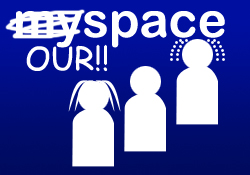
I started learning about web development when I was about 8 years old, already experiencing the web at age 6. Since I was very young I was used to playing with the familiar screen of white text with a black background known as DOS. I always tried to find ways to put my own stuff on that magical screen. I strived to have something different from the infamous “C:\>” prompt that was once my gateway to a world of cheap educational games or whatever my dad would let me do with it back then. I loved hacking away. I loved seeing my work up there. It’s why I love what I do and why I try to learn more about it every day.
As a web developer, like many others, I wonder how MySpace, which followed no rules of web development whatsoever was able to scream to the top of the emerging social networking world and become the phenomenon it is today. I’ve read a lot of blog posts and articles and heard a bunch of podcasts and commentary but not a single source of MySpace dominance opinions comes from the perspective that needs to be seen from, the target.
AOL had it in their hands.
We had a major hint to what social networking needed, and it came from our friends at AOL. It was a simple (and crappy) feature that opened a world of wonder into the lives of others that made AOL Instant Messenger such a popular choice for messaging. It was profiles.
I’m sure the guys on the AIM team didn’t think it would become such a hit and not many people realized it was such a hit either, but teenagers across the country would work extremely hard on making their AIM profile the best of the best. Sub profile websites were among the most popular of websites back then. People could extend their AIM profiles in that same window with links, polls, quizzes, and more. Most importantly, users were able to customize the colors and text to favor their needs.
Where does this behavior come from? Well, have you ever walked into a teenager’s room? When you live with your parents, when you live without a car, and when you live in a house with the customs of your parents, you feel a need to make that one part of the house that you know is yours, well, yours. I look around my room this instant and see nothing on the walls (or on the floor) influenced by anything around the house. It’s all me. Walk into any teenager’s room and chances are that everything you see was placed there specifically by the person who sleeps there every night.
There’s a new home for everyone in the information age and that’s the internet. We know this. We teenagers love it. It’s the one place where our parents can’t change what we have in it and it’s the one place we spend most of our time in nowadays. It’s the new room.
The home we’ve been waiting for.
Every other social networking attempt out there was good. They did it “right.” They were consistent, they were organized, the UI was clean, it was friendly, and it sat there all nice and pretty. Ever walked into a teenager’s room and felt that way? Walk into my room and the first thing you’ll do is trip over my school uniform pants. At that point you’ll look up and you’ll see a Pink Floyd poster followed by a stack of DVDs consisting of a box set of 24 Season One and other action and thriller movies I enjoy. Before MySpace, you could not express yourself the way teenagers express themselves in their room. Friendster and MSN Spaces gave us rooms, but they were more like prison cells. They were ours, we kept our stuff there, and it was unique. But a shadow of strict regulations by constant guard watch and restricted access prevented it from expressing us. MySpace allowed this, but MySpace is not to credit.
MySpace was a prison too. Problem was that security was terrible. People were sneaking in posters, paint, lava lamps, and telephones. And MySpace has only one group to thank: The MySpace layout sites. In a sort-of recent interview, Tom Anderson, President of MySpace, says that a great management team is to thank for MySpace’s rapid growth. I say nay. It was rather the terrible ColdFusion coding skills of the original MySpace team that allowed for so many hacks to be made that people began making their MySpace’s there. Finally there was the freedom we wanted, but at a cost.
During MySpace’s early months, and still even now, MySpace was constantly hacked where Cross-Site Scripting was to blame. People would insert malicious JavaScript code or malicious Flash files in hopes of hacking MySpace accounts or MySpace itself. Now MySpace filters out a lot of the bad code and MySpace is today what it always has been. A terribly coded site with the worst team of programmers who have built the slowest site I have ever used who finally made a website (accidentally) right: ours.
Our personal social war.
There’s also one very important aspect to this social networking thingamajig you guys like ever so much. It’s not just about the networking. It’s a competition. Teens don’t customize their cars to feel more comfortable when walking to the car. Teens don’t decorate their room just to have some sense of achievement. They do it to show off. A fixed up car will make you look like a car expert, an amazing website will make you look like a star website developer, and a frequently visited MySpace with a high friend count will make your social status boom.
In a time and age where social status is everything for teens, some of our kind feel that MySpace is the only way to really make yourself feel like you mean something in your group. A high friend count will show how much people like you or how desperate you are to make people think people like you. The teenage years are crazy times and MySpace seems to have hit the spot (with the help of some third parties of course) for helping us express ourselves the way we want to. Consistency works but creativity prevails. Businesses need consistency, people need creativity. No matter how terrible a MySpace may look, it doesn’t matter at all. The MySpace represents the owner and that’s the type of real estate people are looking for on the web.
It’s a different time and age. The world is smaller. Content creation is easier than ever before and it’s booming. The end-users are now the creators and the controllers. You must accommodate this or you will fail.

